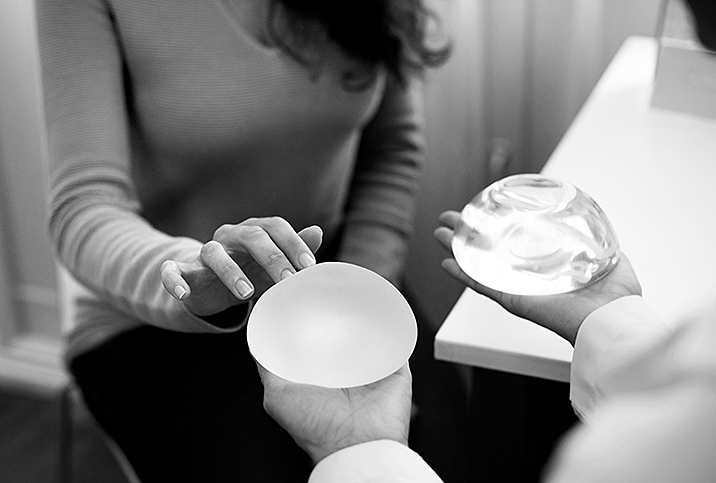Oncoplastic Surgery, the New Frontier in Breast Reconstruction

A medical review in the journal Current Oncology Reports states that over 300,000 women are diagnosed with breast cancer each year in the United States, with more than 3.5 million survivors living with treatment effects.
Long-term survival after breast cancer is not uncommon. The mortality rate for breast cancer has decreased by 40 percent due to new diagnostic techniques and treatment advancements.
Therefore, in the past decade, more attention has turned to the cosmetic result of surgical treatment—alongside cancer removal. Oncoplastic surgery has emerged as a breast cancer treatment option that preserves the aesthetics of the breast while decreasing the risk of additional surgery.
What is oncoplastic surgery?
"Oncoplastic surgery is a surgical approach to breast cancer that reduces the need for additional surgery while preserving cosmetic outcomes. In general terms, oncoplastic surgery is defined as the combination of cancer surgery with plastic surgery techniques, which allows for wide excision around cancer with an emphasis on an optimal aesthetic outcome," said Janie Grumley, M.D., breast surgical oncologist and director of the Margie Petersen Breast Center at Providence Saint John's Center and associate professor of surgery at Saint John's Cancer Institute in Santa Monica, California.
"Essentially, oncoplastic surgery involves the surgical reconstruction of the breasts following the removal of cancerous breast tissue," said Fuat Yüksel, M.D., aesthetic plastic and reconstructive surgeon at Longevita, a medical tourism company in London. "The goal of the surgery is to remove breast cancer and restore the cosmetic appearance of the breasts."
The technique combines breast cancer tumor removal, plastic surgery techniques and breast conservation surgery.
"A plastic surgeon or oncoplastic-trained breast surgeon rearranges the breast tissue to make the breast as beautiful as possible while removing a mass or lump," said Lisa Schneider, M.D., a plastic and reconstructive surgeon at Rowe Plastic Surgery in Jersey City, New Jersey.
Oncoplastic surgery is a growing field
"This procedure is very common for many different kinds of breast masses," Schneider added.
In fact, according to a paper recently published in the Canadian Journal of Surgery, oncoplastic breast surgery is the mainstay of breast cancer surgery in Europe. Researchers said surgeons use oncoplastic surgery in up to 34 percent of patients with breast cancer undergoing breast-conserving surgery. In the United Kingdom, oncoplastic breast surgery is a recognized surgical subspecialty.
Although a standard procedure in Europe, oncoplastic surgery has taken longer to become commonplace in the U.S. The American Society of Breast Surgeons (ASBrS) published data in 2018 indicating its members had a great interest in learning oncoplastic surgery, but less than 20 percent reported performing the procedure.
Who is suited for oncoplastic surgery?
"Most women should be offered the option to have oncoplastic surgery," Grumley said.
Schneider agreed that anyone who can safely undergo elective surgery should be a good candidate.
"However, personal characteristics can make this a poor choice," Schneider explained. "An example includes severe heart disease."
Grumley also said oncoplastic surgery has been shown to be a safe option for patients with large tumors, resulting in fewer morbidities and an excellent cosmetic outcome.
"Even women with large areas of cancer can be considered for oncoplastic surgery," Grumley said. "Some women who may be told they need to have a mastectomy may avoid a mastectomy and reconstruction since this technique allows for removal of larger areas of breast tissue with reshaping of the breast, resulting in a good cosmetic outcome."
"The decision as to the best type of surgery for you and your cancer would usually be advised by your multidisciplinary breast cancer team," Schneider advised. Your healthcare team should discuss every treatment and surgical option with you.
The advantages and disadvantages
As with any surgery, there are pros and cons to oncoplastic procedures. Not every type of surgery is suitable for every person. Grumley, Schneider and Yüksel listed the advantages and disadvantages of oncoplastic surgery as follows:
Advantages
- Lower risk of having to undergo a second operation.
- Better cosmetic outcome and preservation of breast sensation.
- Possible improvement in quality of life, sexuality and familial relations compared with mastectomy, which can sometimes adversely affect a patient's mental health because of the loss of the breasts.
- Possibility of creating a breast that is a better shape and size for you than before surgery. If your breasts are very large, a surgeon can reduce both breasts at the same time as the mass removal.
- No need for implants in some cases because the surgery can use the patient's own body tissue.
- No affect on any ongoing cancer treatment.
- Lower risk of complications and no need for drain placement postsurgery.
- Minimal pain medication is needed postsurgery.
Disadvantages
- The risk of needing another surgery to clear margins is lower, but not completely eliminated. Some patients still need additional surgery to obtain clear margins due to the unpredictable nature of breast cancer.
- These techniques often provide a breast lift, which may result in asymmetry for some patients. However, patients may consider a breast lift on the other side at the time of surgery to improve their breast symmetry.
"This approach has been proven in multiple studies to be medically safe with equivalent survival and breast cancer recurrence when compared to standard surgery," Grumley said. "Research has also shown that this approach reduces the risk of needing multiple surgeries to achieve clear margins, has a lower risk of complications and reduces the need for a mastectomy."
Schneider added that although the oncoplastic technique is very successful, there are some considerations.
"Whether it is right for you will depend on an individualized consultation with your multidisciplinary breast cancer team," she said. "This will take into account different factors like what kind of mass or cancer you have, the size and shape of your breasts, and any medical problems you have."
Know your options
"Talk to a surgeon you trust to make sure you understand everything available to you before the surgery," Schneider advised.
Grumley agreed that patients need to know all their options for breast cancer treatment because there is often a lot to consider.
"Since there are only a few surgeons with this skill set in the U.S., it is important for patients to be their self-advocate and ask [questions]," she stressed. "Most importantly, they need to know that oncoplastic surgery is an option that may provide them with a good cancer operation without compromising the aesthetic and function of the breast."


















